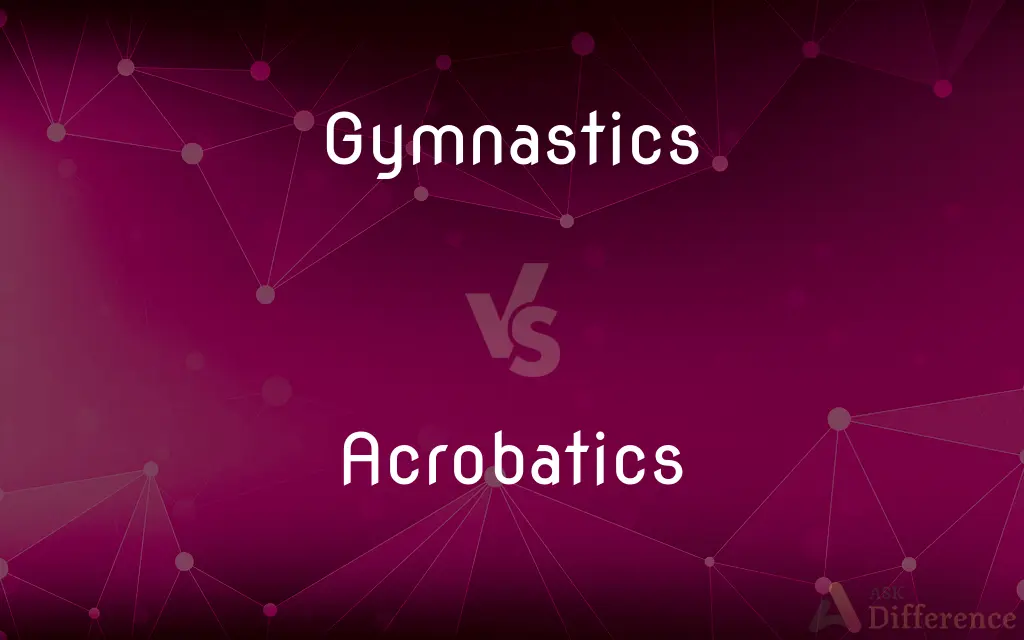Gymnastics vs. Acrobatics — What's the Difference?
Edited by Tayyaba Rehman — By Maham Liaqat — Updated on March 7, 2024
Gymnastics is a sport involving exercises requiring balance, strength, flexibility, agility, coordination, and endurance, while acrobatics focuses on spectacular physical feats and maneuvers, often performed in pairs or groups.

Difference Between Gymnastics and Acrobatics
Table of Contents
ADVERTISEMENT
Key Differences
Gymnastics, recognized as an Olympic sport, encompasses a variety of disciplines including artistic gymnastics, rhythmic gymnastics, and trampoline. Acrobatics, on the other hand, emphasizes more on the performing arts aspect, integrating dance, music, and theatrical techniques to create breathtaking stunts and movements.
While not an Olympic sport, acrobatics is celebrated in circuses, variety shows, and acrobatic gymnastics competitions, highlighting the performers' ability to execute complex flips, balances, and contortions.
The training for gymnastics is rigorous, focusing on developing a wide range of skills that athletes can showcase on various apparatuses, such as the balance beam, bars, and vault. Gymnasts start training at a young age to master the precision and technical skills required for high-level competition.
Acrobatics training, while also demanding, places a greater emphasis on flexibility, partner work, and dynamic movements. Acrobats often specialize in specific acts or routines, honing their skills to perform with exact timing and coordination, especially when working in groups or pairs.
One key distinction between the two is the competitive framework. Gymnastics competitions are highly structured, with set routines and scoring systems governed by international bodies like the International Gymnastics Federation. Acrobatics, while it can be competitive, often thrives in more varied settings where artistic expression and audience engagement are paramount.
ADVERTISEMENT
Comparison Chart
Definition
A sport involving exercises for balance, strength, and flexibility.
Artistic acts focusing on feats of balance, agility, and motor coordination.
Context
Olympic and international sports competitions.
Performing arts, circuses, and variety shows.
Focus
Precision, technique, and execution on specific apparatuses.
Spectacular stunts, partner work, and artistic expression.
Training
Rigorous, starting from a young age, focusing on a wide skill set.
Emphasizes flexibility, timing, and coordination, often in pairs or groups.
Scoring
Structured competitions with specific rules and scoring systems.
More varied, often prioritizing audience impact and artistic value.
Compare with Definitions
Gymnastics
Involvement with equipment like bars, beam, floor, and vault in routines.
His routine on the parallel bars won him a gold medal in gymnastics.
Acrobatics
Acrobatics is often showcased in entertainment settings, emphasizing skillful, dramatic bodily movements.
The circus performers amazed the audience with their daring acrobatics.
Gymnastics
A method to improve strength, agility, and endurance.
Gymnastics training significantly enhances one's physical conditioning and balance.
Acrobatics
Highlights the performer's exceptional flexibility, balance, and strength.
Acrobatics demands an extraordinary level of flexibility and core strength.
Gymnastics
Gymnastics is a competitive sport that involves exercises requiring physical strength, flexibility, and coordination.
She has been training in gymnastics since she was five, aiming for the Olympics.
Acrobatics
Known for breathtaking and often dangerous feats of physical skill.
The acrobatics show featured a tightrope walk that left the crowd in awe.
Gymnastics
Combines athletic skills with artistic elements in routines.
Her floor routine in gymnastics was captivating, blending athleticism with artistry.
Acrobatics
Involves coordinated stunts and routines with one or more partners.
Their acrobatics act, featuring complex aerial stunts, received a standing ovation.
Gymnastics
A sport with structured competitions and international recognition.
Gymnastics is a highlight of the Summer Olympic Games.
Acrobatics
Integrates music, dance, and theatrics for a compelling performance.
The acrobatics routine was a beautiful blend of dance, music, and physical prowess.
Gymnastics
Gymnastics is a sport that includes physical exercises requiring balance, strength, flexibility, agility, coordination, and endurance. The movements involved in gymnastics contribute to the development of the arms, legs, shoulders, back, chest, and abdominal muscle groups.
Acrobatics
Acrobatics (from Ancient Greek ἀκροβατέω, akrobateo, "walk on tiptoe, strut") is the performance of human feats of balance, agility, and motor coordination. Acrobatic skills are used in performing arts, sporting events, and martial arts.
Gymnastics
(used with a pl. verb) Physical exercises designed to develop and display strength, balance, and agility, especially those performed on or with specialized apparatus.
Acrobatics
(used with a pl. verb) The gymnastic moves of an acrobat.
Gymnastics
(used with a sing. verb) The art or practice of such exercises.
Acrobatics
(used with a sing. or pl. verb) The art, skill, or performance of an acrobat.
Gymnastics
Complex intellectual or artistic exercises
Mental gymnastics.
Acrobatics
(used with a pl. verb) A display of spectacular virtuosic skill and agility
Vocal acrobatics.
Gymnastics
(Informal) Feats of physical agility
Had to go through gymnastics to cross the slippery walk.
Acrobatics
The art of performing acrobatic gymnastic feats.
Gymnastics
A sport involving the performance of sequences of movements requiring physical strength, flexibility, and kinesthetic awareness.
Gymnastics was a significant part of the physical education curriculum.
Acrobatics
A spectacular display of agility.
Gymnastics
Complex intellectual or artistic exercises or feats of physical agility.
His mental gymnastics are legendary.
Acrobatics
The gymnastic moves of an acrobat
Gymnastics
Athletic or disciplinary exercises; the art of performing gymnastic exercises.
Acrobatics
The performance of stunts while in flight in an aircraft
Gymnastics
Disciplinary exercises for the intellect or character.
Gymnastics
Feats demonstrating a quick mental agility; as, mental gymnastics, verbal gymnastics.
Gymnastics
A sport that involves exercises intended to display strength and balance and agility
Common Curiosities
What's the main focus of gymnastics compared to acrobatics?
Gymnastics focuses on individual athletic performance and skill demonstration, especially in competitive contexts, while acrobatics emphasizes dramatic, skilled movements often performed for entertainment.
Is specialized equipment required for gymnastics?
Yes, gymnastics often requires specialized equipment like bars, beams, and mats, whereas acrobatics can be performed with minimal or no equipment.
How do scoring systems differ between gymnastics and acrobatics?
Gymnastics has a well-defined scoring system based on execution, difficulty, and artistry, while acrobatics, when competitive, might be judged more subjectively, focusing on creativity, audience impact, and technical skill.
How do gymnastics and acrobatics contribute to physical fitness?
Both disciplines improve strength, flexibility, coordination, and overall fitness, with gymnastics providing a structured approach and acrobatics offering more varied physical challenges.
Can gymnasts perform acrobatics?
Many gymnasts possess the skills to perform acrobatic moves, and cross-training in both disciplines can enhance overall performance.
Are there age requirements for starting gymnastics or acrobatics?
While there are no strict age limits, starting young can be advantageous in both disciplines due to the flexibility and adaptability of younger bodies.
Are acrobatics performed solo or in groups?
Acrobatics can be performed both solo and in groups, with group performances often involving complex coordination and partner stunts.
How do the training regimens for gymnastics and acrobatics compare?
Both require rigorous training; gymnastics emphasizes a broad range of skills across different apparatuses, while acrobatics focuses more on flexibility, balance, and partner work.
Can gymnastics include acrobatic elements?
Yes, gymnastics routines, especially in floor exercises, can incorporate acrobatic elements such as flips and twists.
What's the role of choreography in gymnastics and acrobatics?
Choreography plays a significant role in both, enhancing the artistic presentation in gymnastics and the theatrical impact in acrobatics.
Can acrobatics be considered a sport?
While acrobatics is often seen more as a performing art, its competitive aspects and physical demands allow it to be considered a sport in certain contexts.
Share Your Discovery

Previous Comparison
Crotch vs. Crouch
Next Comparison
Herewith vs. HereinAuthor Spotlight
Written by
Maham LiaqatEdited by
Tayyaba RehmanTayyaba Rehman is a distinguished writer, currently serving as a primary contributor to askdifference.com. As a researcher in semantics and etymology, Tayyaba's passion for the complexity of languages and their distinctions has found a perfect home on the platform. Tayyaba delves into the intricacies of language, distinguishing between commonly confused words and phrases, thereby providing clarity for readers worldwide.
















































